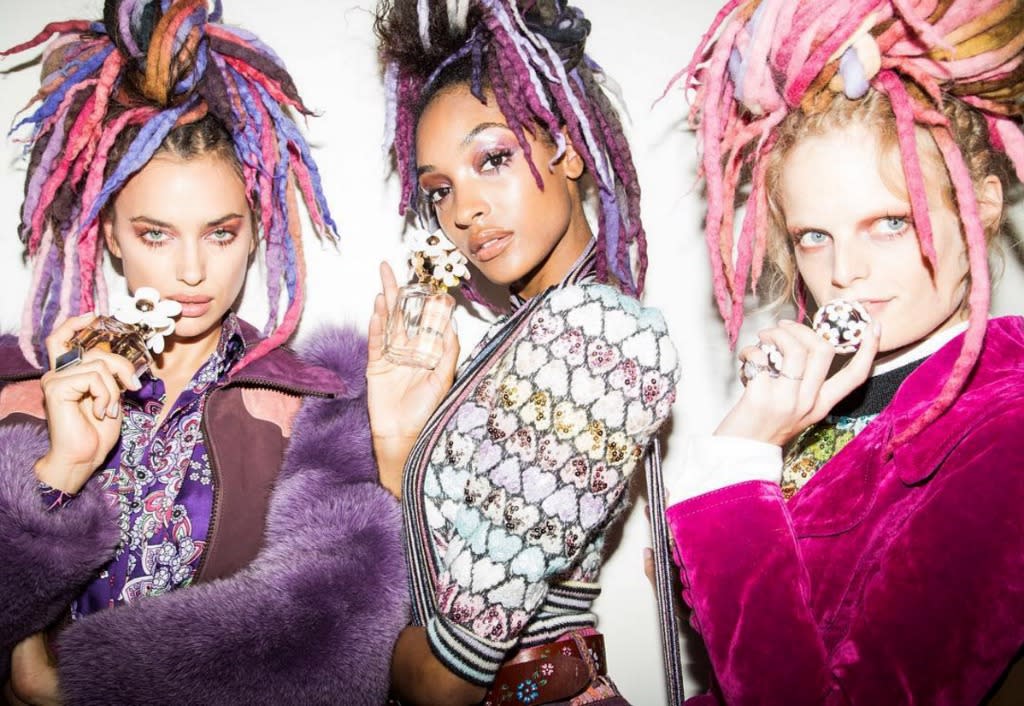People Are Obviously Unhappy About Marc Jacobs’s Dreadlocks

The latest subject of the ongoing debate between stylistic expression and cultural appropriation is designer Marc Jacobs, who sent models down the runway of his spring 2017 New York Fashion Week show in multicolored dreadlocks on Thursday. The models sporting the controversial look included major names like Gigi and Bella Hadid, Kendall Jenner, and Adriana Lima. The locks played up the vibrant rainbow of hues that made up his latest fashion line.
@bellahadid and @kendalljenner backstage at our Spring '17 show ⭐️ #MJSS17
A photo posted by Marc Jacobs (@marcjacobs) on Sep 15, 2016 at 3:02pm PDT
According to US Weekly, Jacobs’s inspiration came from transgender director Lana Wachowski, who the designer features in his spring-summer 2016 ad campaign. In the ads — and in her everyday life — 50-year-old Wachowski’s statement-making style includes a head full of pastel dreads. Jacobs called the campaign, for which Wachowski, who is white, was the first to be signed, a “personal diary” of people who inspire him, according to the Daily Mail. Wachowski and her sister, Lilly, also transgender, are best known for directing The Matrix series and V for Vendetta.
But many people were not as impressed with Jacobs’s muse, her controversial style, or its use in the NYFW show. “Oh yeah. I just realized its #MarcJacobs appropriating black culture with white models,” wrote one angry Twitter user. “I really don’t understand like why? Why do this when you can get beautiful black women who can model better than them?” another questioned. A third echoed the sentiment, adding, “Was super cool until I realized the pastel hair was in dreads. Like a commenter above me said, if that was the look you were going for, use models of color. Would’ve been a great way to be more inclusive and have an amazing show with an otherwise amazing aesthetic.”
Oh yeah. I just realized its #MarcJacobs appropriating black culture with white models. Again. https://t.co/OAs2HKzMrA
— oregon_girl (@oregon_girl3) September 16, 2016
I really don't understand like why?Why do this when you can get beautiful black women who can model better than them pic.twitter.com/wAwDBzvKIu
— Lizeth???? (@radical_lizeth) September 16, 2016
Marc Jacobs just basically said shut up about culture appropriation, and also said he doesn't see color pic.twitter.com/89LhueQQU5
— Affinity Magazine (@TheAffinityMag) September 16, 2016
A writer on XO Jane recently addressed Jacobs’s point — which others have made — about white women failing to accuse black women of cultural appropriation when women of color straighten their hair. “White culture is imposed upon — not adopted by — black people,” said author Chi-Chi Okonkwo.
Jacobs set the wheels in motion for the controversial, colorful dreadlocked look three months ago, when he sent a photo of Wachowski to hairstylist and Redken Global creative director Guido Palau, asking the stylist to help replicate the look for his show. Palau found Jena Counts, who has been dying wool hair extensions in the small town of Palatka, Fla., for about a year. The self-taught pro learned her technique online and has since made 200 to 300 different shades. “It comes in a roping, and you cut it and roll it,” Counts tells Yahoo Beauty. “You can wash them with sulfate-free shampoo to keep the colors.” She sells her custom rainbow-colored creations on Etsy for up to $155 a set.
A photo posted by Marc Jacobs (@marcjacobs) on Sep 15, 2016 at 10:54am PDT
Timid in nature, but supremely talented in skill, Counts told a group of beauty editors backstage hours before the show that she and her daughter dyed a whopping 12,500 yards of wool dreadlocks by hand over a six-day period. They traveled all the way from Florida with extra dyes packed in suitcases, as Palau says Jacobs is very particular about the details.
Addressing the cultural appropriation controversy after the runway show, Palau told the Cut, “I don’t really think about that. I take inspiration from every culture. Style comes from clashing things. It’s always been there — if you’re creative, if you make food, music, and fashion, whatever, you’re inspired by everything. It’s not homogeneous. Different cultures mix all the time. You see it on the street. People don’t dress head-to-toe in just one way.”
Let’s keep in touch! Follow Yahoo Beauty on Facebook, Twitter, Instagram, and Pinterest.

